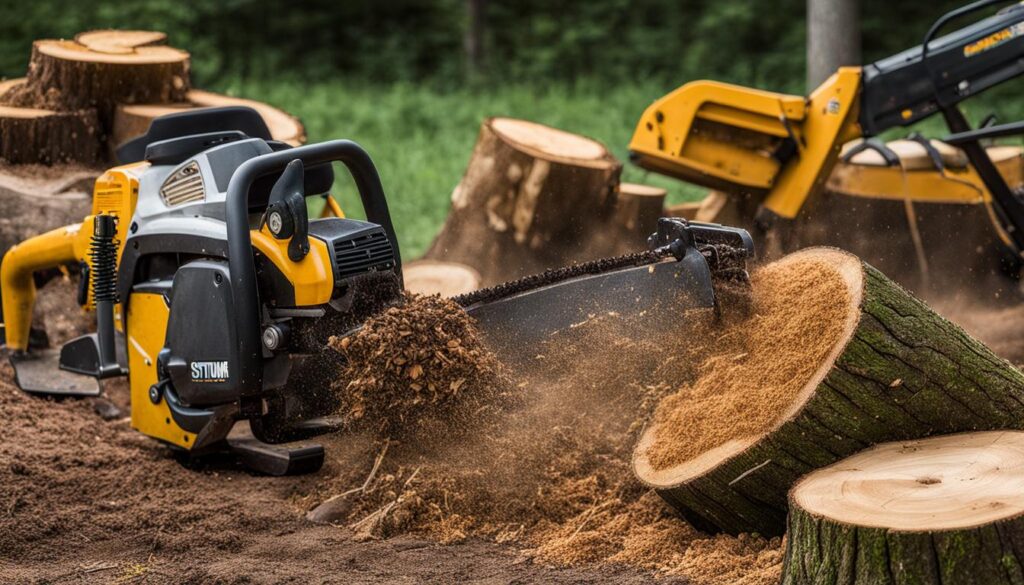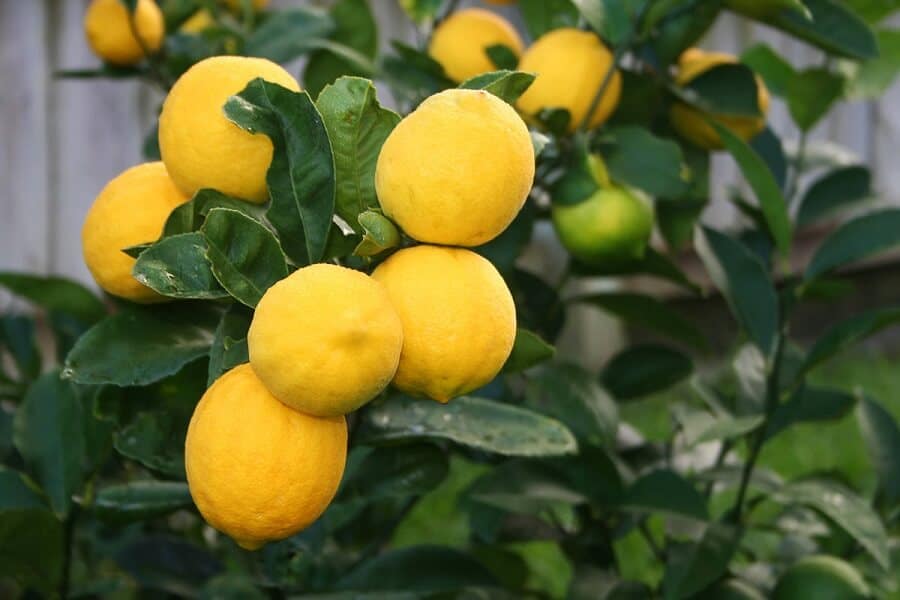Are you wondering about the cost of stump grinding? If you have unsightly tree stumps in your yard, getting rid of them can greatly improve the appearance of your landscape. However, the cost can be a concern for many homeowners. In this article, we will uncover the truth about stump grinding costs and reveal affordable rates that won’t break the bank.
On average, stump grinding prices range between $158 and $450, with most homeowners paying around $313. Of course, the exact cost will depend on several factors, including the size of the stump, the type of stump, the quantity of stumps, and the terrain. Additional services like root removal, tree removal, tree trimming, and tree transplanting can also impact the overall cost.
While hiring a professional is often the best option for stump grinding, it’s worth considering that DIY stump grinding is a possibility. However, this approach requires renting equipment and safety gear, as well as investing your own time and energy.
Now that you have an idea of stump grinding costs, let’s explore the factors that can affect the final price.
Key Takeaways:
- The average cost of stump grinding is around $313 for most homeowners.
- Factors such as stump size, stump type, quantity of stumps, and terrain can affect the final cost.
- Additional services like root removal and tree removal can impact the overall pricing.
- DIY stump grinding is possible but requires equipment rental and safety precautions.
- Considering all the factors, it’s important to evaluate the cost and benefits before deciding on the best approach for stump grinding.
Factors Affecting Stump Grinding Cost
Several factors can affect the cost of stump grinding. These factors should be taken into consideration when estimating the overall expenses of your stump removal project.
The size of the stump is a significant factor that plays a role in determining the cost. Generally, larger stumps will cost more to grind down compared to smaller ones. The complexity of the grinding process increases with the size of the stump, leading to higher labor and equipment costs.
The type of stump also affects the cost. Hardwood stumps, such as oak or maple, are generally harder to grind than softwood stumps like pine or fir. The dense nature of hardwood stumps can require more time and effort, resulting in higher costs.
Another factor to consider is the quantity of stumps that need to be ground. Many stump grinding professionals offer discounts for additional stumps. The price per additional stump is often lower than the initial one, making it more cost-effective to have multiple stumps removed at once.
The completion time of the project can contribute to the final cost. Projects that require longer hours or multiple visits from the stump grinding team may incur higher charges. Additionally, terrain challenges, such as steep slopes or limited access, can also increase the overall cost.
Debris removal is another factor that should be considered. Depending on the contractor, the removal of the grindings and other debris may or may not be included in the initial cost. It’s essential to clarify this beforehand to avoid any unexpected expenses.
Considering these factors will help you estimate the cost of your stump grinding project accurately. Remember to consult with a professional to receive an accurate quote and ensure a smooth and efficient removal process.
Different Methods of Stump Removal
When it comes to removing tree stumps, there are several methods available, each with its own set of pros and cons. Understanding these different methods can help you make an informed decision based on your specific needs and preferences.
Stump Grinding
If you’re looking for a fast and efficient way to remove stumps, stump grinding is a popular choice. This method involves using a specialized grinder to break down the stump into mulch. Stump grinding not only removes the visible portion of the stump but also grinds the underlying roots, making it a comprehensive solution. It is a popular and effective method that ensures the complete elimination of the stump from your property.
Chemical Rotting
Chemical rotting is another method used to remove stumps. This process involves treating the stump with a chemical mixture to promote decay. Over time, the chemicals work to break down the stump, allowing it to rot naturally. Chemical rotting is commonly used for smaller stumps and requires patience, as it can take weeks or even months to fully decompose the stump.
Burning
Burning is a traditional method that involves setting the stump on fire and allowing it to slowly burn over time. While it may be an effective method for removing stumps, it is essential to check local regulations and obtain any necessary permits before attempting this method. Burning can be dangerous and should only be done under controlled conditions with proper safety precautions in place.
Manual Removal
If you prefer a hands-on approach, manual removal may be the right choice for you. This method involves physically digging or pulling out the stump from the ground. While it can be labor-intensive, manual removal allows for complete control over the removal process and is often necessary for larger stumps or when other methods are not feasible.
Each method of stump removal has its advantages and disadvantages. Factors such as the size of the stump, your budget, and the time you’re willing to invest will influence which method is most suitable for your situation. It is recommended to consult with a professional stump removal service to determine the best approach for effectively and safely removing stumps from your property.
Cost Factors for Tree Stump Removal
The cost of tree stump removal can vary based on several factors that influence the overall pricing. It’s essential to consider these cost factors to understand how they can impact your budget and make informed decisions for stump removal.
Stump Size
The size of the stump plays a significant role in determining the cost. Generally, larger stumps require more time and effort to remove, which can result in higher expenses.
Accessibility and Geographic Location
The accessibility of the stump and your geographic location can also affect the cost. Stumps located in challenging-to-reach areas may require additional equipment or techniques, leading to increased pricing. Additionally, regional differences in labor and operating costs can influence the overall price.
Wood’s Age and Tree Type
The age of the wood and the tree type can impact the difficulty of the removal process. Older wood or hardwood stumps may be tougher and more time-consuming to grind, requiring specialized equipment and increasing the cost.
Root System Structure
The complexity of the root system can affect the difficulty of removal. Stumps with extensive or deeply rooted systems may require extra effort for complete removal, potentially affecting the overall cost.
Soil Condition
The condition of the soil around the stump can also influence pricing. If the soil is compacted or rocky, it may require additional time and effort to remove the stump, leading to higher costs.
Removal Method
The chosen method of stump removal can impact the price. Stump grinding is a common and cost-effective option, but other methods like chemical rotting, burning, or manual removal may have different cost considerations.
Number of Stumps
If you have multiple stumps to be removed, discounts may apply. Often, the price per additional stump is lower than the first, allowing for some cost savings.
Preparation and Cleanup Costs
Additional services such as site preparation and cleanup may be necessary, particularly if the area requires clearing or if access is limited. These extra services can contribute to the overall cost.
To get an accurate estimate for tree stump removal, it’s recommended to consult with professional stump removal services. They can assess the specific factors related to your situation and provide you with a detailed cost breakdown.
By understanding these cost factors, you can make an informed decision and ensure that you allocate the necessary budget for effective tree stump removal.
Conclusion
After considering the various factors involved in stump grinding cost, it becomes clear that tree stump removal is an essential investment to improve the overall aesthetics and functionality of your landscape. The national average cost for stump grinding is approximately $313, which can vary depending on the specific circumstances of the project.
Hiring a professional for stump removal is often the most practical and efficient option. Professionals have the necessary expertise and specialized equipment to tackle stump grinding safely and effectively. Their experience ensures that the job is completed in a timely manner, minimizing any potential disruptions to your daily life.
While DIY options may seem appealing, it’s important to consider the additional costs involved. Renting equipment and acquiring safety gear can add to the overall expense. Furthermore, stump grinding requires technical skills and knowledge to ensure efficient and thorough removal. Without the proper expertise, the DIY approach may not yield the desired results.
In conclusion, evaluating the cost and benefits of stump grinding is crucial before making a decision. By hiring a professional, you can enjoy the peace of mind that comes with knowing the job will be done correctly. With their expertise and equipment, they can efficiently remove stumps, enhancing the visual appeal of your property and preventing potential issues. So, when it comes to stump removal, it’s wise to invest in professional services to achieve optimal results and save yourself time and effort.
How Do Bee Removal Costs Compare to Stump Grinding Costs?
When comparing bee removal cost rates to stump grinding costs, it’s important to consider the size of the task at hand. While bee removal cost rates may vary depending on the location and extent of the infestation, stump grinding costs are typically higher due to the labor-intensive nature of the job.
FAQ
How much does stump grinding cost?
On average, stump grinding prices range between $158 and $450, with most homeowners paying $313. The cost can be affected by factors like stump size, project completion time, stump type, quantity of stumps, and terrain.
What factors can affect the cost of stump grinding?
Several factors can affect the cost of stump grinding. The size of the stump is a significant factor, with larger stumps typically costing more. Stump type, quantity of stumps, project completion time, terrain challenges, and debris removal can also contribute to the final cost.
What are the different methods of stump removal?
There are multiple methods for removing tree stumps, including grinding, chemical rotting, burning, and manual removal. Each method has its own pros and cons, and the cost can vary depending on the chosen method.
What factors can influence the cost of tree stump removal?
The cost of tree stump removal is influenced by various factors. Stump size, accessibility, geographic location, wood’s age, tree type, root system structure, soil condition, removal method, number of stumps, and preparation and cleanup costs all play a role in determining the final cost.
Should I hire a professional for stump grinding?
Hiring a professional for stump removal is often the best option, as they have the necessary expertise and equipment. DIY options are available but require additional costs for equipment rental and safety gear. It’s essential to evaluate the cost and benefits before deciding on the best approach for stump grinding.











